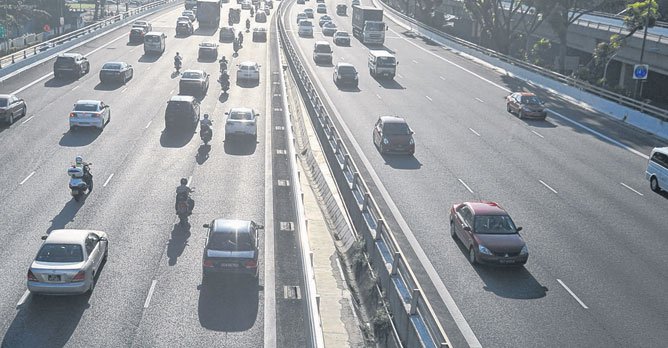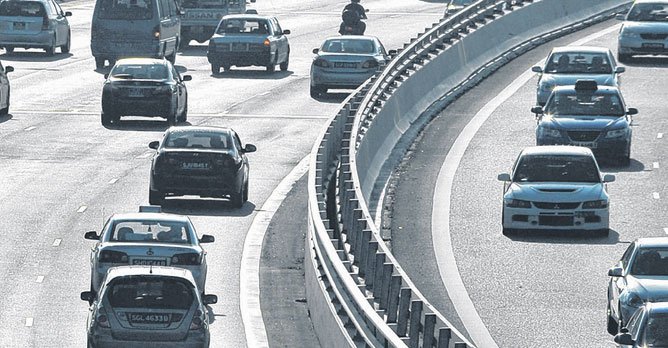Study on feasibility of reverse flow on PIE, KJE
20 Apr 2019|5,117 views
Drivers may one day drive on the wrong side of the road to get to their destination faster.

A reverse-flow scheme allows more lanes to be allocated according to demand over the course of a day. For instance, opposite lanes can be devoted to city-bound traffic during the morning peak by a movable divider. The process is reversed during the evening peak, when flow is highest away from the city.
The $12.5 million study will help the Land Transport Authority (LTA) decide whether to implement the system, which was last used here on the Nicoll Highway in the 1960s.
An LTA spokesman told The Straits Times, "This scheme is ideal for land-scarce Singapore.” A stretch along the KJE-PIE was selected as it connects residential areas in the north to jobs in the west, the spokesman added. The authority will review the next steps when the study is completed by this year.
The cost of the advanced engineering consultancy study includes physical works such as soil investigation, topographical surveys and trial excavations to determine the location of any underground utilities such as water pipes and electrical or telecommunication wiring.

Retired Traffic Planner Joseph Yee said such a scheme can be challenging over a long stretch of highway, noting that there will be a period when signal lights on both ends will have to be red to facilitate a safe switchover.
"Nicoll Highway is short, so the all-red time was short," he said. "The longer a road is, the longer the all-red. And the longer the all-red, the more unacceptable it becomes for road users." It can also be precarious if the changeover is not done well. Mr. Yee added that the centre divider and trees will have to be removed to facilitate such a scheme.
Mr. Loh Chow Kuang, President of Consultancy, Singapore Urban Transport, said, "Expressways operate at high speed, with several entrances and exits along the way. Safety is a chief issue if flows on some lanes were to be reversed, notwithstanding many other engineering and operational issues. "The feasibility will have to be carefully and thoroughly studied with all safety, engineering and operational issues addressed," Mr. Loh added.
Transport literature indicates that reverse-flow schemes were once popular back in the 1970s and are now making a comeback. But they can also be hazardous. When the reverse-flow scheme was first implemented on the Golden Gate Bridge, there were so many head-on collisions in the middle lanes that they were dubbed 'suicide lanes', reported transportation publication CityLab.
Drivers may one day drive on the wrong side of the road to get to their destination faster.

A reverse-flow scheme allows more lanes to be allocated according to demand over the course of a day. For instance, opposite lanes can be devoted to city-bound traffic during the morning peak by a movable divider. The process is reversed during the evening peak, when flow is highest away from the city.
The $12.5 million study will help the Land Transport Authority (LTA) decide whether to implement the system, which was last used here on the Nicoll Highway in the 1960s.
An LTA spokesman told The Straits Times, "This scheme is ideal for land-scarce Singapore.” A stretch along the KJE-PIE was selected as it connects residential areas in the north to jobs in the west, the spokesman added. The authority will review the next steps when the study is completed by this year.
The cost of the advanced engineering consultancy study includes physical works such as soil investigation, topographical surveys and trial excavations to determine the location of any underground utilities such as water pipes and electrical or telecommunication wiring.

Retired Traffic Planner Joseph Yee said such a scheme can be challenging over a long stretch of highway, noting that there will be a period when signal lights on both ends will have to be red to facilitate a safe switchover.
"Nicoll Highway is short, so the all-red time was short," he said. "The longer a road is, the longer the all-red. And the longer the all-red, the more unacceptable it becomes for road users." It can also be precarious if the changeover is not done well. Mr. Yee added that the centre divider and trees will have to be removed to facilitate such a scheme.
Mr. Loh Chow Kuang, President of Consultancy, Singapore Urban Transport, said, "Expressways operate at high speed, with several entrances and exits along the way. Safety is a chief issue if flows on some lanes were to be reversed, notwithstanding many other engineering and operational issues. "The feasibility will have to be carefully and thoroughly studied with all safety, engineering and operational issues addressed," Mr. Loh added.
Transport literature indicates that reverse-flow schemes were once popular back in the 1970s and are now making a comeback. But they can also be hazardous. When the reverse-flow scheme was first implemented on the Golden Gate Bridge, there were so many head-on collisions in the middle lanes that they were dubbed 'suicide lanes', reported transportation publication CityLab.
Latest COE Prices
May 2025 | 1st BIDDING
NEXT TENDER: 21 May 2025
CAT A$103,009
CAT B$119,890
CAT C$62,590
CAT E$118,889
View Full Results Thank You For Your Subscription.



















